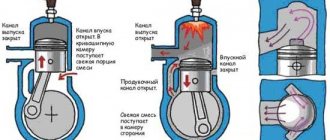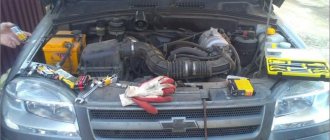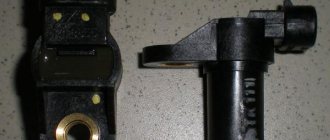The catalyst plays one of the important roles in the operation of the Chevrolet Niva engine. It reduces noise, engine operation, and also helps protect the environment from the gases produced by the engine; this component cleans these exhaust gases. But with all this, the catalyst also has a number of disadvantages, such as: • Suppression of a certain number of horsepower • It is not reliable enough, and quite often needs repairs. Untimely repair work can lead to noise with rattling.
Some resort to complete removal of the catalyst; the pros and cons of this appear in almost equal measure. One of the significant advantages of removing this component of the car is a reduction in fuel consumption, since a clogged catalyst contributes to an increase in gasoline consumption. But before resorting to this removal procedure, you should know all the pros and cons of this, and do not forget that every element in the car is installed there for a reason.
Catalyst device
What do spare parts manufacturers offer?
On the shelves of auto stores you can find all kinds of parts for tuning the exhaust system.
The production of mechanical simulators of the normal operation of the catalytic converter is made of bronze or chrome-plated steel. The price of such devices ranges from 400 to 800 rubles, and a standard installation at a service station will cost about 500 rubles. A spacer with a minicatalyst is offered much more expensive than its elementary counterpart, its cost is 1,500-4,000 rubles. Simple electronic emulators of industrial production are sold for 1,500-3,000 rubles. The range of prices for flashing ECU software is quite wide - from 1,000 to 30,000 rubles.
Hello, dear friends! I would like to study in more detail such an issue as replacing the catalyst with a flame arrester. Many people strive to carry out such a procedure, sometimes without understanding what it can lead to.
But I will try to be as objective as possible. I will tell you not only about the consequences, but also about what positive aspects arise when replacing the standard catalyst in the exhaust system of a car with a flame arrester or stronger. This is the same concept, but it is the flame arrester that is most widespread among car enthusiasts.
This is not to say that this is a universal element that can be installed always and everywhere. We need to understand this issue and get the most important answers.
The principle of operation of the flame arrester
During operation, the flame arrester receives exhaust gases that enter the exhaust system, processes them and removes them. At the exit, the temperature of the gases becomes significantly lower, and their speed drops significantly.
In addition, the flame arrester breaks the primary flow of gases that come from the collector. This approach is used for the purpose of stable operation of the main resonator.
In addition, the flame arrester mixes all the unstable flows ufpjd from the cylinders into one stable flow. Thanks to the design of the body of the part itself, the flame arrester significantly reduces the level of noise that appears inside it due to the beating of gases.
.34. Three in one - or how to protect the catalyst
Replacing a failed catalyst will not be cheap, so it would be good to know in advance what problems there are with it, and how things stand with them on the spare parts market.
Until recently, we only knew the following about the catalyst: it is a thing that is not clear why it is needed, it is not clear how it works, that our gasoline “kills” it, in general - nothing but troubles. Cut - and no problem! But gradually we began to get used to the fact that the catalyst is still a useful thing, at least the thoughts of “surgical intervention” in the exhaust system are visited less and less often by fewer and fewer people.
In the spring, when traffic police officers begin the “fight for clean air,” another problem falls on us - we need to regulate the CO. Owners of cars equipped with catalysts don’t even think about it, and they pass CO checkpoints without trembling knees or fear for their wallet. True, the same wallet can “lose a lot of weight” for another reason.
How do they work?
When the working mixture is burned, a number of combustion products harmful to human health are formed, in particular, carbon monoxide (CO), various hydrocarbons (CH) and nitrogen oxides (NO). Although these substances make up only 1% of the total exhaust (the rest is nitrogen, carbon dioxide and water vapor), they are very harmful and require neutralization.
As experts say, a catalytic converter is a simple device in which a complex chemical process occurs. “Inside the stainless steel case there is a ceramic or metal “brick” that has a honeycomb structure. This monolith has a huge surface area, and all of it is covered with a thin layer of a special alloy - the catalyst itself, containing platinum, rhodium and palladium. It is these precious metals that are responsible for the wonderful properties of the catalyst, and they also determine its high cost.”
Exhaust gases “wash” the surface of the monolith, and when the temperature reaches a “critical” value of 270° C, the catalytic reaction begins. Carbon monoxide is converted to dioxide (carbon dioxide), hydrocarbons are converted to water and again carbon dioxide, and oxides of nitrogen are converted to water and nitrogen. All this is less harmful to the environment.
Also interesting: How to remove the crankshaft pulley of a VAZ 2114 yourself: instructions, photos and videos - Automaster
Catalytic converters can quite effectively reduce exhaust toxicity, while they do not affect fuel consumption and engine power. In the presence of a catalyst, the exhaust back pressure slightly increases, causing the engine to lose 2-3 hp, but this is practically the entire “payment” for cleaning the exhaust.
Why do they replace?
I won’t tell anyone a secret if I say that the decision to replace the catalyst with a flame arrester is largely due to the economic component. That is, the car owner simply wants to save money.
Just look at the cost of this element. If we take into account even domestic cars, the price tag will look impressive. Now imagine that your VAZ has already covered about 200-300 thousand kilometers. And here the need arises to change the catalyst. Such a purchase will cost 50-70 thousand rubles.
If you decide to install such a design for yourself, do not forget about the mandatory equipment of a stronger with blende. Decoy, catalyst emulator, lambda decoy. Call it what you want. This will not change the essence.
The lambda decoy serves to correct the incoming signal from the oxygen sensor to the electronic control unit of your car. Moreover, it is necessary to install such a device if a flame arrester is installed in place of the catalyst.
Without doing this, the ECU will begin to perceive the operation of the exhaust system as problematic, and the emergency mode of operation of the internal combustion engine will begin to constantly turn on. This will result in a decrease in engine life and an increase in fuel consumption.
Similar designs, made from stronger and blende, can be installed on any car:
- Mazda 3;
- Hyundai Elantra;
- Chevrolet Lacetti;
- Ford Focus;
- Renault Megane;
- Toyota Prado 120;
- Hyundai Solaris;
- Opel Astra;
- Niva Chevrolet;
- Kia Rio, etc.
The use of deception should not be ignored. You already know about the consequences of such a rash decision.
How to properly remove a catalyst on a Chevrolet Niva
Qualified specialists professionally handle the removal of catalysts on Chevrolet Niva cars. To quickly resume normal operation of the exhaust system, order services from our technical center. Our technicians will carefully cut out the catalytic converter using the necessary equipment and tools. Compliance with established instructions is the main rule of our specialists’ work.
Cutting out a faulty exhaust system device is carried out sequentially. Specialists competently perform the work:
- dismantle the catalyst, taking into account the characteristics of the machine;
- remove ceramics;
- install flame arresters if the upper catalyst is cut out;
- install a lambda probe blende;
- They reprogram the car's electronic system.
Malfunction of the catalyst: characteristic signs
On a Chevrolet Niva, the average service life of the catalyst is about 70 thousand kilometers. However, the need for replacement may come sooner. This is influenced by operational factors.
Signs of catalytic converter degradation:
- Check engine indicator. The ECU will indicate a malfunction because the sensor in the catalyst will indicate incorrect data. The indicator will light up instantly.
- Reduced motor power. Failure of the catalyst leads to difficulty in removing exhaust gases. It is difficult for inexperienced drivers to feel this moment. It is clearly visible only at high speeds on the highway when overtaking or in advanced cases, when there is little left of the cells.
- Increased fuel consumption. The lambda probe provides the ECU with incorrect data, which causes a lean mixture to be supplied to the engine. The reduction in power forces the driver to press the gas pedal harder. This leads to an increase in fuel consumption - by 10-15% on average.
- Problems starting the engine. Clogging of the catalyst honeycomb makes it difficult for exhaust gases to flow out. The cylinders are not completely cleaned. Starting becomes difficult.
Experienced mechanics will give an accurate assessment of the problem. Malfunctions in the car engine are a reason to contact a service center.
The effect of a clogged system on the machine
If the particulate filter is clogged, it can still be revived. It is necessary to urgently respond to a malfunction, since delay will result in additional costs. At one point the engine simply won’t start or stalls immediately.
Consequences of operating a faulty catalyst:
- melting of the muffler or the ceramic element itself;
- unstable engine operation and loss of power, sometimes noticeable;
- increase in fuel consumption;
- poor exhaust gas removal;
- soot or pieces of ceramic getting into the cylinders - a major overhaul is possible after this.
The possible consequences of delaying repairs exceed the cost of the removal procedure. Engine repairs will cost much more.
Preliminary nuances
Let's start with the simple concept of a catalyst, which for some reason they want to replace with their own hands or the hands of a craftsman with a flame arrester. The catalyst is a device that is part of the exhaust system. It serves to purify gases produced during fuel combustion from all kinds of impurities.
But if this device breaks down or becomes dirty, returning it to its original level of performance is not so easy. In fact, car owners make one of 2 decisions. In the first case, they buy a new part and install it in place of the old one. The second option is to replace the catalyst with a device called a flame arrester.
Also interesting: NIVA and NIVA-Chevrolet spare parts catalogs - Shop of auto parts and accessories for Niva and NIVA-Chevrolet cars
Car enthusiasts are divided into 2 camps. Some argue that installing a stronger is an excellent tuning solution. Others are confident that such modernization will only cause harm.
But how dangerous would it actually be to remove the catalyst? And if this is harmful, then why do service stations actively offer this service in Yekaterinburg, St. Petersburg, cities such as Moscow, Voronezh, Volgograd and other parts of the country? And the price isn't that bad.
It's all about the myths that have formed around flame arresters. They look like this:
- the motor begins to quickly fail;
- the muffler breaks down;
- the engine is very noisy;
- exhaust gases become more dangerous in their composition;
- great harm is caused to nature;
- in the cabin you can be poisoned by the exhaust;
- the engine consumes fuel in huge quantities;
- motor life is reduced significantly;
- the exhaust system lasts quite a bit, etc.
But it was not in vain that I focused on the fact that these are myths. Most of them are very far from the truth.
Therefore, now we need to study all the pros and cons, consider the essence and concept of a flame arrester, and come to the appropriate conclusions.
The essence of a stronger
Based on the principle of operation, there is much in common between a damper and a resonator. But the task of the first is to dampen sound waves and vibrations from the engine, as well as at the same time reduce the temperature of the exhaust gases.
In simple words, you can describe a stronger like this. This is a device that performs 2 functions simultaneously. Namely, it reduces the temperature, lowering it to a level that is safe for the car and specifically the exhaust system itself, and also reduces the noise level. This automatically refutes some of the myths presented earlier. Thus, you can already draw some of your own conclusions regarding the fairness of blaming the flame arrester for all the troubles associated with the exhaust system of the car.
If we talk about installation, it is carried out on the car muffler pipe, or in the exhaust manifold itself. This allows you to distinguish the main (on the pipe) and collector stronger.
Moreover, according to experts, there is no significant difference in noise level. After replacement, as confirmed by reviews from motorists, the noise of the car even decreases.
Adviсe
Whatever method is used, it is important to know that after removing the catalyst, the electronic unit will still show an error. This is accompanied by a yellow "Check Engine" light. And all because the oxygen sensor will record incorrect data about the amount of oxygen remaining in the catalyst. How to solve this issue?
Another method is flashing the electronic unit. However, it is better to do this operation at a service station. The essence of the process is to install software for Euro-2. Thus, the ECU will not have information about the catalyst, and the engine will operate normally without additional interference. This method is relevant if the catalyst is removed at a service station. After all, in the service, the installation of a flame arrester is carried out in conjunction with the firmware of the electronic unit.
Also note that the length of the common exhaust system pipe does not change. Therefore, you should not install a new rear bumper on the Chevrolet Niva (whether it is restyling or pre-restyling, it does not matter). The system will operate normally. The only thing that will change for the worse is the smell of gas.
Replacement methods
So, what to do if a catalytic converter malfunction has been diagnosed? You can try to replace the filter element with a new one. This will be correct from an environmental point of view. But from a budget point of view, replacement will entail significant expenses. After all, a new catalyst on a Chevrolet Niva costs from 15 thousand rubles, and it is not a fact that it will last 70 thousand kilometers. Thus, owners resort to different alternatives. This:
- Removing the Chevrolet Niva catalyst and then installing a flame arrester.
- Knocking out the ceramic filler of the old neutralizer.
We will look at the features of each method below in the article.
Signs
How to determine that this element has failed? It is impossible to determine the malfunction by mileage. On average, catalysts on a Chevrolet Niva last about 70 thousand kilometers. But it may require replacement earlier. Therefore, you need to be guided by indirect signs:
- The first symptom is the “Check Engine” lamp on the instrument panel. It will definitely light up if the catalytic converter malfunctions. The sensor installed in the filter element will receive incorrect data, causing an error to appear in the ECU.
- Reduced power. The reason for this is the difficult removal of gases through the system. The honeycombs may be melted or simply clogged. As a result, gases cannot escape freely into the atmosphere. As a result, the car will lose power and acceleration dynamics.
- Fuel consumption. The increase in consumption is due to several factors. Firstly, the ECU will be guided by the average values of the lambda probe, which is why the mixture will be too lean. Secondly, due to the reduction in power, the driver mechanically presses the pedal harder than usual. This increases fuel consumption. As practice shows, the car begins to spend 10-15 percent higher than usual.
Ways to solve problems
One of the reasons that the car’s performance has decreased may be due to mechanical damage to the CAT. Since this device is covered with ceramics inside, and if the exhaust pipe hits any surface strongly, this ceramics can fly apart, which will lead to a characteristic noise, in which case it will not be possible to repair it, in this case there are several options:
- Buy a new catalyst module
- Knock out the CAT present in it
- Replace a clogged catalyst with a flame arrester (stronger)
Each method has both its advantages and disadvantages. Buying a new one is costly; getting rid of the catalytic module and replacing its metal insert can lead to the operation of the muffling system being disrupted, since hot exhaust will begin to enter there, and a characteristic sound will appear when driving; the advantage of this method is its low cost. Many people resort to replacing it with a flame arrester because it is not expensive, and the bonus will be an increase in engine response.
And also interesting: Selection of oil for the Chevrolet Niva engine. Useful tips.
To summarize, we can conclude about the pros and cons of removing this element. The advantages include the fact that fuel consumption will decrease due to the fact that some recycled particles will no longer be recycled and will go back into consumption. And the main disadvantages include:
- An error will appear on the dashboard
- A characteristic noise will appear
- A car without it will be classified as an emergency vehicle.
- The unpleasant odor will intensify, which, in addition to polluting the environment, will seep into the cabin.
Therefore, whether to leave, replace, or completely remove the catalyst, whether it will be done independently or by specialists, will, of course, be decided by the car owner himself.
When the catalytic converter fails, the engine can no longer operate normally. The electronic panel displays errors that indicate a malfunction of the exhaust system. Only experienced technicians can quickly solve catalytic converter problems.
Our company has been servicing cars for many years. We guarantee a professional approach to solving any problems with machines. If you need to remove the catalyst, use the services of our specialists. They will do the job efficiently, while the cost of maintenance will be low. The technical center provides services daily. You can place an order for catalytic converter cutting not only on weekdays, but also on weekends.
Advantages and disadvantages of removal
Before talking about its disadvantages and advantages, you should first of all pay attention to the conditions under which it is used. Because if, for example, the ignition is faulty or the fuel is of insufficient quality, then all this, if not applied, affects its operation and leads to failure. Therefore, if the car has problems with dynamics, or gasoline consumption has increased, the first thing you should pay attention to is the condition of the exhaust system. The normal operation of the element, or as it is called CAT, is designed for 50-150 thousand kilometers, and its service life directly depends on the conditions under which it is operated.
Therefore, before resorting to a complete replacement of a part, pay attention to how the ignition system is adjusted, what fuel is used, this all directly affects its operation. It is also important to use high-quality oils; this is also an important aspect related to how long the catalyst will last.
As for repair work, this procedure is not complicated, you can do it yourself, without the help of specialists, this will help you save money, since a new part is not cheap, and if you entrust this work to a specialist, it will be quite expensive. Of course, if you do not have free time and you do not have problems with money, then you can resort to the help of a specialist.
Removing the catalyst on the field 21214: consequences
Once removed, you will notice a significant increase in power. But let us immediately note that it will be within the factory values. After all, before this, the engine simply suffocated on its own gases and the power could drop by almost half. Gases will freely leave the combustion chamber - the risk of valve burnout is minimal.
Fuel consumption after removing the catalyst is within the factory values. But malfunctions will occur very rarely. After all, “when cold” the ECU is guided by average lambda values. And so on until the catalyst warms up. After removing it and flashing it, the unit will think that the neutralizer is already warmed up and will immediately begin to prepare the correct mixture.
The car will become less demanding on the quality of the fuel used. Even if there are deposits, all the dirt will fly straight into the pipe without being trapped in the filter honeycombs.
As for the negative aspects, after such “tuning” your environmental standards will immediately drop to Euro-2. But in Russia there are no penalties for this. It is completely legal to drive a Chevrolet Niva without a catalyst.
Instructions for making a flame arrester with your own hands
Then we stretch the mesh brushes in a circle in the form of a ring, put them on a pipe of a smaller diameter and push them tightly with a metal strip until it rests on the closed end of a pipe of a larger diameter. We continue this procedure until the last mesh brush reaches the free end of a larger diameter pipe. It took me 26 mesh brushes to fill the empty space.
After this, we bend the ends of the pipe of larger diameter, pre-cut with a grinder, and scald them in a circle. This procedure helps to avoid unnecessary ringing noises from the flame arrester during engine operation. For beauty, you can paint it with silver spray paint. Now, with peace of mind, we cut out the catalyst and weld the manufactured flame arrester in its place.
PS A flame arrester instead of a catalyst can be installed on cars with Euro standard 2. On cars with Euro standard above 2, there is an oxygen sensor lambda probe after the catalyst and removing it can lead to an error in the engine control unit, which in turn will increase fuel consumption and worsen dynamics car.
Alternatively, you can make a flame arrester with your own hands on a VAZ
We take an old resonator, it is 2 years old and 45t.km. For the flame arrester body we needed an old muffler. We cut the muffler into metal.
The outer casing of the drain muffler is 2 layers of metal - 0.6 mm on the outside; from the inside - 0.8 mm., by the way, well preserved, slight corrosion between these two layers of metal. Next, look carefully at the photo, everything is clear.
The outer diameter of the cut pipe is 80 mm, thickness 1.5 mm, will be used for the flame arrester body.
We use the remaining piece for the end walls, then, due to the reluctance to cut the resonator pipe in half due to the further complexity of the joining, we did this: the flame arrester body was welded, cut lengthwise:
We put the halves on, scald them, then on the outside with a second layer we weld a 0.8 mm thick shirt onto the flanges of the end walls with a gap between the shirts of about 5 mm, the flanges are visible in the previous photos, the result:
On the end walls there is also an additional layer of metal 0.8 mm
then on the flame arrester body there is a noise-sound-heat insulator - a cover with flanges with asbestos fabric inside
We cook the lining from the bottom of the car
Similarly, on the bottom side there is a lining with asbestos for the resonator, we cook:
By the way, there is a decent stench when paraffins come out of asbestos... from heating. Now we clean with a cleaning disc and a metal brush
We degrease and paint with thermal paint (otherwise it will quickly corrode during welding, all welded seams should be thoroughly cleaned with a brush) thermal paint is stated to reach 538 degrees Celsius, we’ll see... By the way, one can was enough to paint three layers, there was one extra can left...
Now in a week I’ll install it somewhere, now I won’t have time, the plans are to remove the old (new) resonator, remove the thermal shields from the bottom, clean and cover the barrier with 2 layers of vibration-mastic, reassemble it in place, and by the way, reinforced suspension cushions of the resonator (weight -something has increased), I hope the metallic sound will go away, or it will become much less, in any case, I will approach the assessment of changes carefully and as objectively as possible, otherwise I somehow got into trouble with the SAAB... The original muffler is straight-through, and these Saab ones are for turbo- engines, the turbine itself dampens the sound quite well and the task there is to remove the exhaust as easily as possible. By the way, between the wall of the original resonator and the outer pipe 1.5 mm thick, I was afraid to shove stainless steel dish brushes, in case they start rubbing against vibrations and pressure and pour into the exhaust or even into the engine, write comments and we’ll discuss
Yes, I almost forgot - the stock silencer has stainless steel end walls and an exhaust tip, a mysterious Russian soul, if the 2 outer skins were made of stainless steel, it would be an indestructible silencer because Everything inside is practically new.
Removing a Chevrolet Niva catalyst: preliminary diagnostics
To accurately verify the malfunction, you will need computer diagnostics of the engine.
At the service station this procedure is performed as follows. The wizard connects to the OBD-2 connector and scans for errors using a laptop. On a Chevrolet Niva they will have the following code:
All these errors indicate “ineffective operation of the neutralization system and the lambda probe heater.”
After diagnosis, the specialist makes a decision. This could be replacing the lambda probe (this also happens with a working catalyst, at a mileage of up to 40 thousand), or completely removing the catalytic filter.
If we consider indirect symptoms, it could be:
- toxic odor of exhaust gases;
- metallic rattling and ringing in the muffler.
In the latter case, the ceramic part of the catalyst may peel off. It cannot freely leave the system and causes a characteristic rumble.











